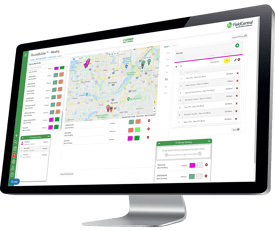
Last week, Google announced Project Fi, a new mobile network designed to eliminate a lot of the annoyances consumers face when using mobile service. The project, currently in invite-only mode, aims to make mobile networks easier to understand and use. Google eschews the traditional model by offering pay-for-what-you-use pricing, pairing two mobile networks as well as public Wi-Fi for better coverage, and offering more international functionality.
For most green industry businesses using mobile field service software like HindSite, paying for data plans for multiple employees can be an expensive proposition, especially if they use one of the heavy hitters like Verizon or AT&T. So the idea that they could use a potentially inexpensive solution like Google Fi has some appeal.
But is Google Fi a good solution for a typical green industry business? Let’s take a look at some of the pros and cons:
Why Google Fi is Great for Your Business
-
The plans can be inexpensive if you don't use a lot of data. What makes Google Fi intriguing is that you basically pay for the data you use. Their base price is $20, which gets you unlimited talk and text. Then, you pay $10 for each gigabyte (GB) of mobile data you use. Note that it’s only cellular data - if you are connected to wi-fi and use data, it’s not counted. We’re in the process of implementing data measurement into our field service software, but our impression is most of our customers use less than 1GB a month when using HindSite. So your monthly cost could be as low as $30.
-
Google Fi innovates in some ways that may benefit your business. There are a couple interesting innovations in Google Fi. For one, they’ve reached agreements with both T-Mobile and Sprint. Those carriers' networking infrastructure serves as the cellular backbone for Google Fi. Which isn’t unusual - a number of what are called MVNOs deliver cellular service without actually owning any infrastructure. What makes Google Fi unique, however, is that they’ve partnered with multiple carriers and their technology switches seamlessly between T-Mobile and Sprint, depending on which carrier has the best network where you are. For a business with a pretty big service footprint, that means if one area of your service territory has great T-Mobile service and another has great Sprint service, you get better coverage.
One of the more underreported aspects of Google Fi is its Wi-Fi functionality. Google claims to have a network of millions of public Wi-Fi hotspots that it can use to provide service to Google Fi users. Plus, Google has solved one of the major issues with using open Wi-Fi, namely that it’s not secure and your transmissions can be read by other people using that hotspot with very minimal work. Not if you’re using Google Fi. They encrypt all their traffic using a Google VPN.
Google hasn’t released details about its Wi-Fi network, but if the network is big enough and the coverage good enough, your green industry business could potentially get coverage where cellular service is spotty - with the added bonus that you’re not using any cellular data. -
The device compatible with Google Fi is a great device for mobile field service software. When our customers ask us what device they should use for their business, we always tell them a tablet is their best bet. For one, we’ve heard that property owners complain if they see a worker at their property using their phone. They misinterpret that phone usage as personal time, not work time. Tablets are more accepted as part of the work. Plus, tablets tend to stay in the truck. Their size means your field workers are less inclined to bring them out into the field. As a result, they are less likely to break and need replacement. Lastly, entering data onto a small phone isn’t easy.
At launch, the Nexus 6 is the only device compatible with Google Fi. It’s expected that more devices will be announced in the future, but today, the Nexus 6 is the only option. It’s a big phone with a 6 inch screen. It’s really closer to a small tablet than a traditional phone. So for all the reasons mentioned above, it’s a great solution for a business.
Why You Don't Want to Use Google Fi in Your Business.
-
You may be able to find a business or family plan at a much lower cost point, especially if you have many employees. Google Fi offers no family or multi-user plans. If you have a lot of field employees and currently get a significant discount with a group or family plan, Google Fi may actually cost you more.
-
Your choice of devices is severely limited (and expensive) today. I mentioned before that the Nexus 6 as the only device that currently works with Google Fi. It’s a great phone, but the downside is it’s not cheap. A 32GB version runs about $650 while the 64GB version will set you back around $700. Google will let you pay off the phone over two years - at a cost of roughly $25 to $30 a month depending on the phone (and assuming you have good credit). For a typical business, spending $700 for a device for each employee or crew is a non-starter.
-
The network may not work if you’re in a rural area. With Google Fi, you’re relying on T-Mobile and Sprint mobile networks. Even when combined, you most likely don’t get the type of coverage you’d get with a leading carrier like AT&T or Verizon. T-Mobile and Sprint seem to cover the major metro areas well, but if you service rural areas, your service may be spotty at best. Check out the Fi coverage map to see if Google Fi is a good fit for your business.
Google Fi is definitely an exciting new shot across the bow by Google. Their goal isn’t necessarily to compete with incumbents like Verizon and AT&T head on, but to enact change that gives more consumers access to inexpensive mobile data.
Is it right for your green industry business? Today, that’s unlikely. Due to the high costs and extremely limited device selection, the second-tier networks it uses, and the inability to get a bulk discount, it’s probably more suited to individual use than use in your business. But that doesn’t mean it’s not worth watching. We expect Google to continue to innovate to drive down Internet costs. Much like they did with Google Fiber, we expect them to start small, but quickly innovate and bring new features and functionality to the mobile network arena.
Wondering what else you should be using in your business? Then check out the 2015 Green Industry Benchmark Report to learn what your peers are doing to improve their businesses.








